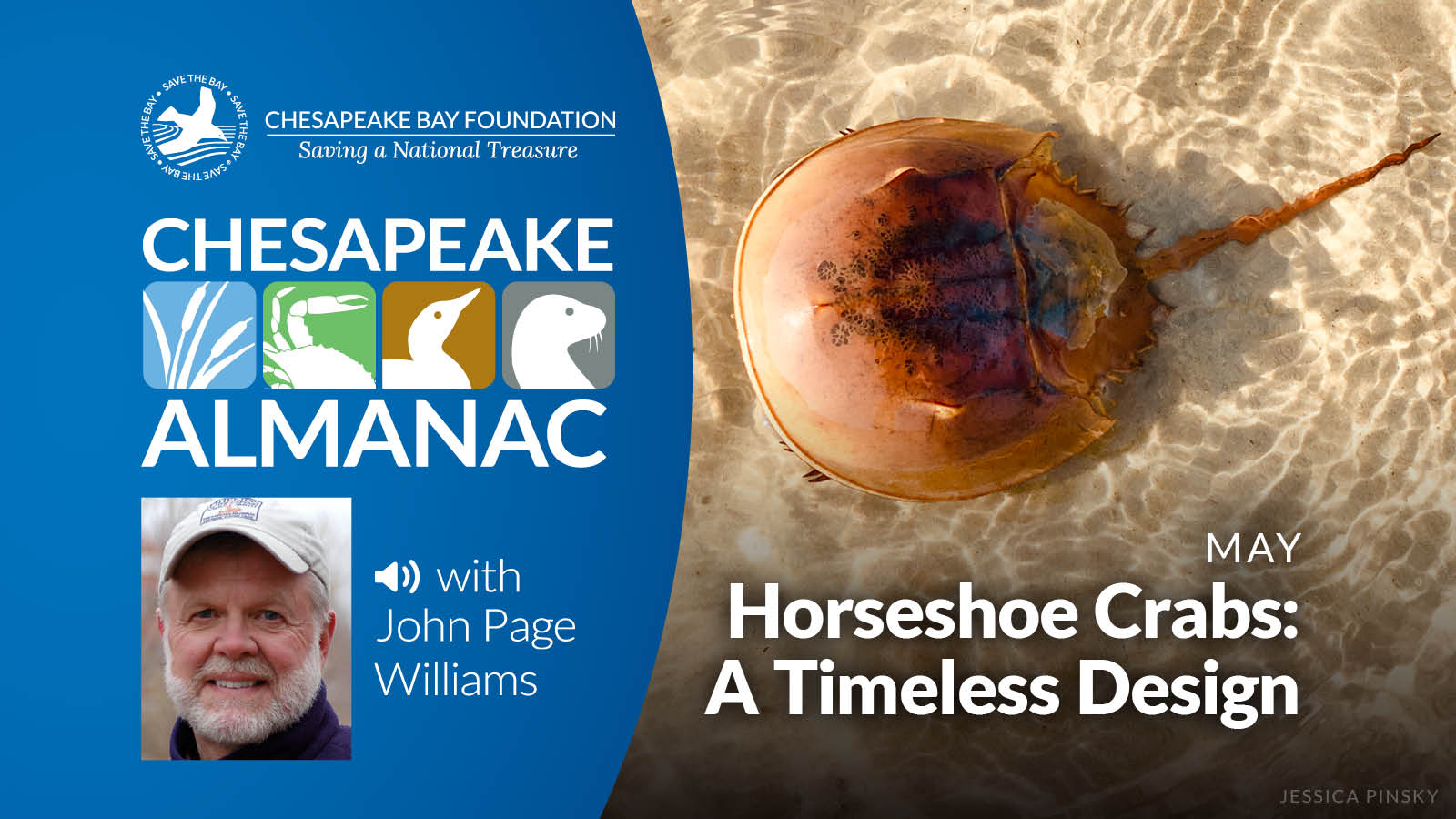
Podcast Transcript: Chesapeake Almanac
Episode 8: May: Horseshoe Crabs—A Timeless Design
Copyright © John Page Williams Jr. All rights reserved.
This is John Page Williams with another reading from Chesapeake Almanac. The month is May and this sketch is entitled, "Horseshoe Crabs: A Timeless Design."
May is the beginning of horseshoe crab spawning season on the Chesapeake. For much of the, year the animals live in the deeper channels of the Bay and lower rivers, but this month they come into the shallows by the thousands, to breed and lay their eggs.
Breeding time can be spectacular--big brown crabs everywhere in the shallows, along sandy shores and marsh banks. The careful observer will note that much of the activity centers around especially high tides that we refer to as "spring tides" coinciding with the full and new moons. The females, each dragging at least one male mounted on her back, crawl up the water's edge, dig shallow nests, and deposit their eggs, which the males fertilize.
While the tide is high, a female and her mate will produce several nests, but if the tide falls before the female has deposited all her eggs (about a quart), the pair will retreat to deeper water and try again on the next high tide. Their aim is to deposit the eggs as high on the beach as possible without leaving the water.
A large number of eggs are eaten almost immediately, as killifish, eels, and other fish dart around and even under the mating crabs. But they must work at their feeding, for the water is very shallow, and they too must retreat as the tide falls. Gulls and shorebirds feed on the newly laid eggs also, and they sometimes uncover nests later.
But horseshoe crabs apparently lay enough eggs to compensate for the appetite of those predators, and the species survives. The eggs stay buried in the sand, which becomes a moist incubator in the warming spring sun. In two weeks, when the next spring tide brings high water again, the eggs will have developed enough for young horseshoe crabs to hatch and move out into the shallows.
The strategy of working around the tides seems sensible enough to us, but there is more to think about here than just an animal's adaptation to the lunar cycle, interesting though that is. What is remarkable is that the horseshoe crabs behavior was probably developed at a time when there were no fish to prey on the eggs when they were laid, and no birds or land animals to feed on them after the tides receded. The horseshoe crab came into being before any of them. We actually have no assurance that those ancestral crabs followed the same strategy of laying eggs in the uppermost reaches of spring tides, but they may well have done so. If they did, the scheme was a good one, for there were very few predators around to disturb the eggs after they were laid.
All this was going on about 400 million years ago, a time so far in the past that it's hard for us to comprehend. When we beach our fiberglass skiffs and aluminum canoes to watch the horseshoe crabs spawning, the time warp is staggering. Even the primitive plants that produced the fossil fuel gasoline for the skiffs' outboards came a hundred million years after the first horseshoe crabs. They predate the origin of the Atlantic Ocean itself, which apparently was born from a rift in the great super continent of Pangaea some 250 million years ago.
Down through the ages, the horseshoe crabs have survived great changes in the earth and its community of living things. They are, in fact, so old that they cannot be classified as crabs at all. Our beloved blue crab is a much more recent development. The horseshoe crabs are certainly related to the ancestors of the blue crab, but they are classified in a group off by themselves, more closely related to spiders than to anything else.
What allows an animal's design to survive so much change in its environment over so long a time? The question cannot be answered definitely, but it is interesting to work out some educated guesses. The horseshoe crab is simple and unspecialized. For the much of the year, it probes the bottom in the channels, feeling its way along to pick up worms, small clams, and other bottom dwellers. Its diet is broad, allowing it to take advantage of whatever is available.
Most of the time, the shell offers excellent protection. It protects the crab from attack from almost any direction, and it appears to be stable enough to hold bottom in turbulent currents.
There are no big claws, legs, or tails holding large quantities of meat to make the horseshoe crabs attractive prey. They do have predators, including man, but the level of predation is relatively low.
The horseshoe crabs go their way, slowly, methodically, with little complex behavior. They are the oldest animal design with which we have contact here in the Chesapeake.
For more happenings around the Bay in May see our other Chesapeake Almanac podcasts and read our blog posts "The Dirt on Soil Health" and "A Mahogany Tide in May."
Subscribe to this podcast at https://chesapeake-almanac.captivate.fm/listen


